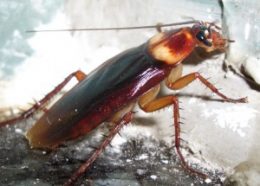Cockroaches could be good medicine
Ground-up bug brains are shown to kill resistant bacteria

Scientists recently reported on a disgusting new idea for human health: The ground-up brains of cockroaches, they say, may help fight infectious diseases.
To most of us, not even a spoonful of sugar is going to help that medicine go down.
Cockroaches are insects with simple, small brains. But tangled up in those tiny heads are chemical compounds that can kill E. coli and MRSA, two harmful bacteria.
Some kinds of E. coli live peacefully in the intestines of human beings. But when a person accidentally eats food or drinks water contaminated with E. coli, look out. She can become violently ill. E. colican cause vomiting, diarrhea, respiratory problems and pneumonia. One type of E. coli can also cause meningitis.
MRSA can be bad, too. MRSA stands for methicillin-resistant Staphylococcus aureus, which means it’s a type of Staphylococcus aureus that can’t be killed by the antibiotic methicillin, and even other antibiotic medicines like penicillin or amoxicillin. This tiny germ can cause skin infections — which can become big problems in hospitals. Since it’s so difficult for doctors to treat MRSA, ground-up cockroach brains could help a lot of people.
Simon Lee and Naveed Kahn are two microbiologists who worked on this study, and they both do research at Nottingham University in the United Kingdom. A biologist is a scientist who studies living things, and a microbiologists studies very small living things — like bacteria.
The scientists decided to study insects after noticing an interesting pattern. Some soldiers who came back from the Middle East were sick with strange infections — but locusts from the same areas were infection-free. (Locusts are types of grasshoppers.) The scientists started to wonder how insects that live in unhygienic places manage to avoid infection.
“Some of these insects live in the filthiest places ever known to man,” Khan told Science News. “These insects crawl on dead tissue, in sewage, in drainage areas. We thought, ‘How do they cope with all the bacteria and parasites?’”
To find out, the researchers ground up different parts of locusts and cockroaches and put the mixtures in Petri dishes with types of the harmful bacteria. In dishes with the fat and muscle tissue and blood of the insects, the bacteria survived. Because the bacteria didn’t die, the researchers had to keep looking.
Ground-up tissue from cockroach and locust brains and locust nerves, however, killed almost all the harmful bacteria — nearly 100 percent. That means that the bug brains and nerves must contain chemicals that kill the bacteria.
It’s too soon to go to your local drugstore and ask for cockroach brains to treat an infection, but that might be a reality in the future. The scientists are now trying to figure out which chemicals fight infection. One day those chemicals may help humans.
But not today. Today, cockroaches are still nasty little insects. Stay tuned.
Power words (adapted from the Yahoo! Kids Dictionary)
Bacterium (plural bacteria) A single-celled microorganism of the class Schizomycetes. Bacteria vary in terms of appearance and oxygen and nutritional requirements. They may be free-living, and they can be either helpful or disease-causing in plants and animals.
Antibiotic A substance, such as penicillin or streptomycin, produced by or derived from certain fungi, bacteria and other organisms, that can destroy or inhibit the growth of other microorganisms.
Penicillin Any of a group of antibiotic drugs obtained from penicillium molds or produced synthetically, and being most active against gram-positive bacteria and and used in the treatment of various infections and diseases.
Petri dish A shallow circular dish with a loose-fitting cover, used to culture bacteria or other microorganisms.







